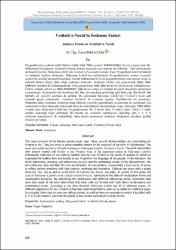| dc.contributor.author | Uysal, Bilal | |
| dc.date.accessioned | 2023-09-05T11:39:52Z | |
| dc.date.available | 2023-09-05T11:39:52Z | |
| dc.date.issued | 26.09.2022 | en_US |
| dc.identifier.citation | Uysal, B. (2022). Vesîletü’n-Necât’ta Seslenme Sözleri . Afyon Kocatepe Üniversitesi Sosyal Bilimler Dergisi , 24 (3) , 839-860 . DOI: 10.32709/akusosbil.1122161 | en_US |
| dc.identifier.uri | https://dergipark.org.tr/tr/pub/akusosbil/issue/72686/1122161 | |
| dc.identifier.uri | https://hdl.handle.net/11630/10661 | |
| dc.description.abstract | Peygamberimizi anlatan edebî türlerin (naat, siyer, hilye, şemail, Muhammediye vb.) en yaygın olanı Hz. Muhammed‟in doğumu vesilesiyle kaleme alınmış manzum veya mensur mevlidlerdir. Türk edebiyatında en başarılı mevlid, Süleyman Çelebi‟nin Vesîletü’n-Necât adlı eseridir. Eser, Peygambere içten bir hürmet ve sadakatle kaleme alınmıştır. Süleyman Çelebi‟nin milletimizin Peygamberimize sonsuz sevgisini coşkun bir şekilde yansıtabilmesindeki önemli noktalardan birisi de peygamberimize olan sonsuz sevgi ve sadakati halkın diliyle ifade ettiği seslenme sözleridir. Seslenme sözleri için alanyazında hitap, nida, seslenme terimleri de kullanılmaktadır. Eski gramerlerde nida, daha sonra ise ünlem terimi kullanılmıştır. Ünlem, özünde yüksek ses ifade etmektedir; yüksek ses, vurgu ve tonlama ile çeşitli duyguları yansıtmaya yaramaktadır. Seslenmeler tek sözcükten (Ey, hey, âh) meydana gelebildiği gibi öbek yapı (Ey Habîb, hey yavrum, âh gençlik) şeklinde de görülür. Bu çalışmada Süleyman Çelebi‟nin Vesîletü’n-Necât adlı eserinde geçen seslenmeler; seslenme biçimleri ve seslenme yapıları başlıklarında ele alınmıştır. Muhataba farklı seslenme sözleriyle hitap edilmek suretiyle eşgöndergeli seslenmeler de yapılmıştır. Bu seslenmelerin hem doğrudan ünlemlerle hem de ünlemliklerle oluşturulduğu tespit edilmiştir. Elde edilen verilere göre Süleyman Çelebi‟nin Peygamberimize 48 (3 farklı isim, 45 farklı sıfat); Allah‟a 5 farklı şekilde seslendiği tespit edilmiştir. Bir beyitte tek seslenme işaretleyicisi olabildiği gibi 2, 3, 4, 6 seslenme işaretleyicisi ile seslenildiği, hatta beytin tamamının seslenme öbeğinden meydana geldiği örnekler de vardır. | en_US |
| dc.description.abstract | The most common of the literary genres (naat, siyer, hilye, şemail, Muhammediye, etc.) describing our Prophet is Hz. They are verse or prose mawlids written on the occasion of the birth of Muhammad. The most successful mawlid in Turkish literature is Süleyman Çelebi's Vesîletü'n-Necât. The work was written with sincere respect and loyalty to the Prophet. One of the important points in Süleyman Çelebi's enthusiastic reflection of our nation's endless love for our Prophet is the words of address in which he expressed the endless love and loyalty to our Prophet in the language of the people. In the literature, the terms addressing, shouting, and addressing are also used for addressing words. In the old grammars, the term nida was used, and later the term exclamation. An exclamation is essentially a loud sound; It serves to reflect various emotions with high volume, emphasis and intonation. Callouts can occur with a single word (Ey, hey, âh) as well as in the form of a phrase (Ey Habîb, hey baby, âh youth). In this study, the calls in Süleyman Çelebi's work called Vesîletü'n-Necât; addressed in the titles of vocalization forms and vocalization structures. By addressing the interlocutor with different addressing words, consonant calls were also made. It has been determined that these calls are formed with both direct exclamations and exclamation points. According to the data obtained, Süleyman Çelebi had 48 (3 different names, 45 different adjectives) for our Prophet; It has been determined that he calls out to Allah in 5 different ways. In a couplet, there may be only one callout marker, as well as there are examples in which it is called with 2, 3, 4, 6 call markers, and even the whole of the couplet consists of a voiced phrase. | en_US |
| dc.language.iso | tur | en_US |
| dc.publisher | Afyon Kocatepe Üniversitesi | en_US |
| dc.identifier.doi | 10.32709/akusosbil.1122161 | en_US |
| dc.rights | info:eu-repo/semantics/openAccess | en_US |
| dc.subject | Ünlem | en_US |
| dc.subject | Seslenme | en_US |
| dc.subject | Süleyman Çelebi | en_US |
| dc.subject | Vesîletü‟n-Necât | en_US |
| dc.subject | Öbek | en_US |
| dc.subject | Exclamation | en_US |
| dc.subject | Calling | en_US |
| dc.subject | Süleyman Çelebi | en_US |
| dc.subject | Phrase | en_US |
| dc.title | Vesîletü’n-Necât’ta seslenme sözleri | en_US |
| dc.title.alternative | Address forms in Vesîletü’n-Necât | en_US |
| dc.type | article | en_US |
| dc.relation.journal | Afyon Kocatepe Üniversitesi Sosyal Bilimler Dergisi | en_US |
| dc.department | Fakülteler, Eğitim Fakültesi, Türkçe ve Sosyal Bilimler Eğitimi Bölümü | en_US |
| dc.authorid | 0000-0002-7198-8760 | en_US |
| dc.identifier.volume | 24 | en_US |
| dc.identifier.startpage | 839 | en_US |
| dc.identifier.endpage | 860 | en_US |
| dc.identifier.issue | 3 | en_US |
| dc.relation.publicationcategory | Makale - Ulusal Hakemli Dergi - Kurum Öğretim Elemanı | en_US |
| dc.contributor.institutionauthor | Uysal, Bilal | |



















